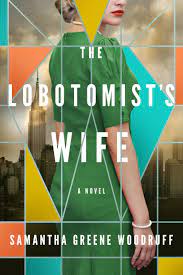Writing THE LOBOTOMIST’S WIFE: A Braid of Facts and Imagination
 Writing is my second act. Almost a decade ago, after I gave up my full-time corporate job to take care of my two young children, I found myself searching for something “of my own” outside of the home. I’ve always liked to write but hadn’t considered a novel until I took a beginner novel workshop at The Writing Institute at Sarah Lawrence. I started writing a contemporary novel about a suburban housewife dissatisfied with her “charmed” life. It wasn’t great.
Writing is my second act. Almost a decade ago, after I gave up my full-time corporate job to take care of my two young children, I found myself searching for something “of my own” outside of the home. I’ve always liked to write but hadn’t considered a novel until I took a beginner novel workshop at The Writing Institute at Sarah Lawrence. I started writing a contemporary novel about a suburban housewife dissatisfied with her “charmed” life. It wasn’t great.
At about two years and 200 pages into my writing (and now in an intermediate novel class!) I had an epiphany. I was listening to Get Well Soon: History’s Worst Plagues and The Heroes Who Faught Them by Jennifer Wright and she included a chapter on lobotomy and Walter Freeman II (1895 –1972,) the doctor who popularized the procedure in the United States. I had a vague notion of what lobotomy was, but no idea that the heyday of this gruesome treatment was in the middle of the 20th century. Or that, by the early 1950s, Freeman was prescribing his out-patient “ice pick” technique for everything from migraines to depression, and more than half of his private patients were women.
Suddenly, it hit me: what if my unhappy housewife lived in the early 1950s instead of today, when lobotomy was a feasible “solution” for her misery?
The Lobotomist’s Wife was born.
This was also the beginning of the #MeToo movement, and I saw the story evolving in my head as a riff on these same dynamics of female power and exploitation. I wanted to write a book that was really about the struggle for people (especially women) to find their way, in a world where identity and the prescription for happiness is externally dictated. I also wanted it to be a fast-moving page-turner with elements of a thriller. Easy, right?
I was a history major in college, so I was excited by doing research. Still, I envisioned a novel that spanned three decades with impeccable historical accuracy and gave readers a history of a macabre medical procedure without turning them off. It was overwhelming. What ultimately saved me was to break my research into digestible chunks. I built the book character by character, researching specifics to shape their worlds and background. My non-negotiables were that the book factually adhere to the timeline of lobotomy, and that each character’s life experience be historically feasible; beyond that, I gave my imagination free reign.
I started with Margaret, the 1950s housewife who I thought would be my protagonist. When lobotomy was being performed, the field of mental health was modernizing, but much of the malaise that was felt by females was still minimized as “women’s ailments.” I wanted to capture this with Margaret’s dilemma. She both suffers from a legitimate mental illness that was not recognized as such at the time (postpartum depression,) and carries scars common to so many independent-minded women who worked on the home front during WWII. How would it have felt to go from having an intense sense of purpose outside of the home to suddenly being told: “thanks for that, now your whole life should be making a nice house and family for your husband. And you should be thrilled?” Margaret wants her life to be enough but, try as she might, it isn’t. That’s why she is selling Tupperware, and why she embraces the idea of lobotomy – because she will do anything to be who she thinks she is supposed to be.
Ruth is the most fictional of my three main characters. She came to be when a writer friend asked, early on, if Freeman had a wife and what she was like. I started to wonder what kind of woman could stand by a man who was doing something so awful to so many people, to so many women. There isn’t much information on Freeman’s actual wife, and what I learned is that she wasn’t at all the woman I would have imagined. I created the wife I wanted instead. My lobotomist’s wife was a strong woman who came freely to work in the world of mental health. That’s why I made her an heiress. Her work, unusual for the time and her position, is her passion. She believes in lobotomy. But she is also blinded by love and her need to believe in miracles. As I developed Ruth, I understood that she, not Margaret, was my protagonist, and that her relationship with her husband was the central conflict in my novel. Ruth is the vehicle for the reader to understand why lobotomy was so well received in the first place, but she is also the ultimate instrument for change.
Robert, the last character in my trinity, was in some ways the most challenging because he is inspired by someone real. I learned a lot about lobotomy before writing Robert, but I stayed away from Jack El-Hai’s terrific biography of Walter Freeman II, The Lobotomist, until I had a clear picture of who Robert, my lobotomist, was going to be. Ultimately, I used factual specifics from The Lobotomist to give Robert more dimension – the most outrageous details in my book come from real life – things that would seem unrealistic if I had made them up. I intentionally changed other aspects to distinguish between the two men — some of the biggest shifts were moving the setting from Washington D.C. to New York and, of course, the specifics of his marriage.
Having completed this novel, I see writing historical fiction like weaving a braid – you pull together fact and invention for a journey into something that dances on the line between real and imagined. My greatest hope is that readers will ask “Is that true?” and be sparked to do their own research to find out.
—
ABOUT SAMANTHA GREENE WOODRUFF
 Samantha Greene Woodruff has a BA in history from Wesleyan University and an MBA from the NYU Stern School of Business. She spent most of her career telling stories to executives at MTV Networks as the senior vice president of strategy and business development and, subsequently, audience research for the Nickelodeon Kids & Family Group. After leaving corporate life, she pursued her varied passions, teaching yoga, cooking, and taking classes at the Writing Institute at Sarah Lawrence College. It was here that she combined her multifaceted background with her wild imagination and passion for history, reading, and writing. The Lobotomist’s Wife is her first historical fiction novel, and she is already at work on her next book. Sam lives in southern Connecticut with her husband, two children, and two dogs.
Samantha Greene Woodruff has a BA in history from Wesleyan University and an MBA from the NYU Stern School of Business. She spent most of her career telling stories to executives at MTV Networks as the senior vice president of strategy and business development and, subsequently, audience research for the Nickelodeon Kids & Family Group. After leaving corporate life, she pursued her varied passions, teaching yoga, cooking, and taking classes at the Writing Institute at Sarah Lawrence College. It was here that she combined her multifaceted background with her wild imagination and passion for history, reading, and writing. The Lobotomist’s Wife is her first historical fiction novel, and she is already at work on her next book. Sam lives in southern Connecticut with her husband, two children, and two dogs.
Connect with Samantha!
Website: samanthawoodruff.com
Instagram: @samgwoodruffauthor
Facebook: Sam G Woodruff Author
THE LOBOTOMIST’S WIFE
An enthralling historical novel of a compassionate and relentless woman, a cutting-edge breakthrough in psychiatry, and a nightmare in the making.
Since her brother took his life after WWI, Ruth Emeraldine has had one goal: to help those suffering from mental illness. Then she falls in love with charismatic Robert Apter—a brilliant doctor championing a radical new treatment, the lobotomy. Ruth believes in it as a miracle treatment and in Robert as its genius pioneer. But as her husband spirals into deluded megalomania, Ruth can’t ignore her growing suspicions. Robert is operating on patients recklessly, often with horrific results. And a vulnerable young mother, Margaret Baxter, is poised to be his next victim.
Margaret can barely get out of bed, let alone care for her infant. When Dr. Apter diagnoses her with the baby blues and proposes a lobotomy, she believes the procedure is her only hope. Only Ruth can save her—and scores of others—from the harrowing consequences of Robert’s ambitions.
Inspired by a shocking chapter in medical history, The Lobotomist’s Wife is a galvanizing novel of a woman fighting against the most grievous odds, of ego, and of the best intentions gone horribly awry.
Buy HERE
Category: How To and Tips























